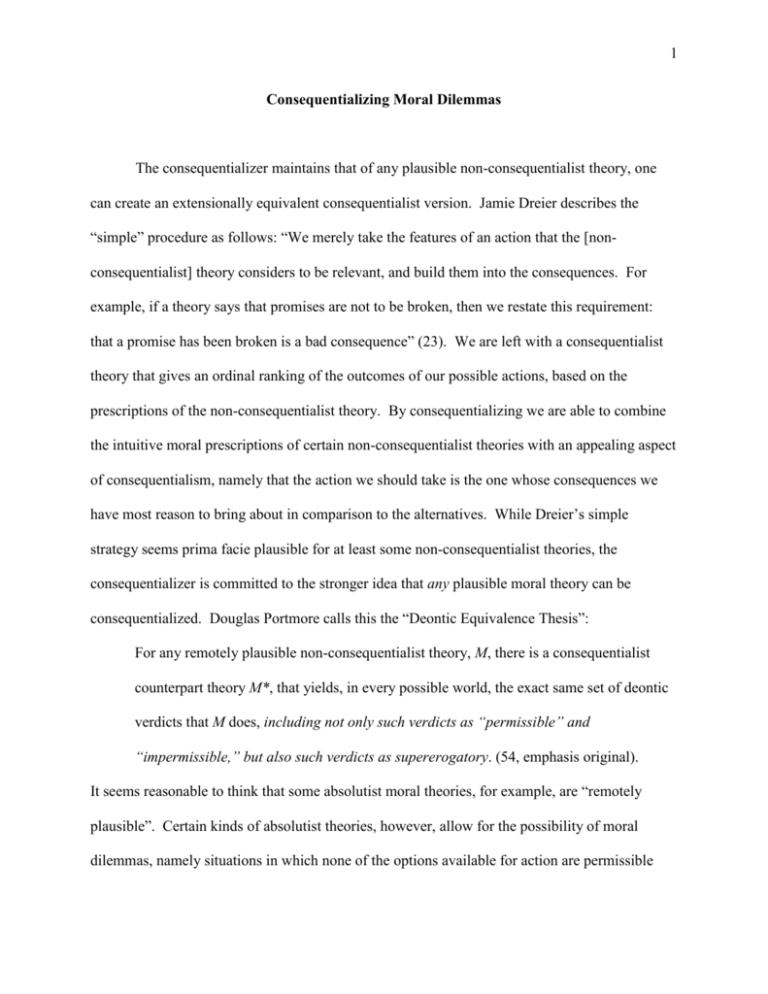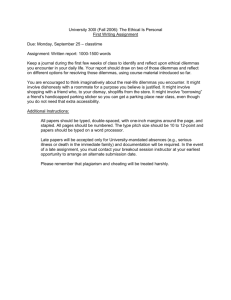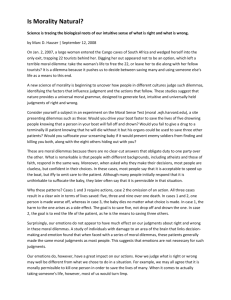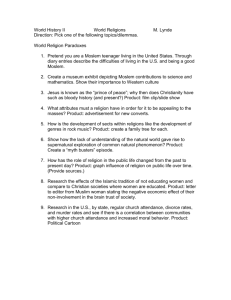Consequentializing Moral Dilemmas
advertisement

1 Consequentializing Moral Dilemmas The consequentializer maintains that of any plausible non-consequentialist theory, one can create an extensionally equivalent consequentialist version. Jamie Dreier describes the “simple” procedure as follows: “We merely take the features of an action that the [nonconsequentialist] theory considers to be relevant, and build them into the consequences. For example, if a theory says that promises are not to be broken, then we restate this requirement: that a promise has been broken is a bad consequence” (23). We are left with a consequentialist theory that gives an ordinal ranking of the outcomes of our possible actions, based on the prescriptions of the non-consequentialist theory. By consequentializing we are able to combine the intuitive moral prescriptions of certain non-consequentialist theories with an appealing aspect of consequentialism, namely that the action we should take is the one whose consequences we have most reason to bring about in comparison to the alternatives. While Dreier’s simple strategy seems prima facie plausible for at least some non-consequentialist theories, the consequentializer is committed to the stronger idea that any plausible moral theory can be consequentialized. Douglas Portmore calls this the “Deontic Equivalence Thesis”: For any remotely plausible non-consequentialist theory, M, there is a consequentialist counterpart theory M*, that yields, in every possible world, the exact same set of deontic verdicts that M does, including not only such verdicts as “permissible” and “impermissible,” but also such verdicts as supererogatory. (54, emphasis original). It seems reasonable to think that some absolutist moral theories, for example, are “remotely plausible”. Certain kinds of absolutist theories, however, allow for the possibility of moral dilemmas, namely situations in which none of the options available for action are permissible 2 (prohibition dilemmas), or where we are obligated to perform more than one action which cannot simultaneously be fulfilled (obligation dilemmas). If the consequentializer wants to be able to maintain the deontic equivalence thesis then she needs to be able to account for moral dilemmas in consequentialized versions of absolutist (and potentially other kinds of) moral theories, otherwise the non-consequentialist moral theory and its consequentialist counterpart will give different deontic verdicts in certain situations. Exactly how this can be done is not obvious. Here I will look at a few possible strategies that the consequentializer can employ, focussing specifically on Portmore’s solution that he proposes in “Consequentializing”. I will argue that although a strategy like Portmore’s can uphold the deontic equivalence thesis (inasmuch as the consequentializer can represent the statuses of various actions by means of relations within an ordinal ranking), it is problematic for two reasons: first, it will result in consequentialist theories that differ from their non-consequentialized counterparts in a number of important ways, and second, it will ultimately end up undermining the so-called “attractive” features of consequentialism. The flaws in Portmore’s theory point to the kinds of factors that the consequentializer needs to take into account when dealing with moral dilemmas. With these requirements in mind, I propose a possible alternative solution that the consequentializer can use to represent moral theories that allow for the possibility of dilemmas. Kinds of Dilemmas Peter Vallentyne considers two possible kinds of dilemmas that a non-consequentialist theory might allow: obligation dilemmas and prohibition dilemmas. Obligation dilemmas occur when one is faced with a decision between incomparable acts where more than one act is obligatory; prohibition dilemmas are those in which all of the possible actions one is able to perform are prohibited. If plausible moral theories entail these kinds of dilemmas, then the 3 consequentializer needs to be able to construct an extensionally equivalent set of prescriptions that captures the nature of these dilemmas. It’s not obvious whether consequentialist theories can accommodate these kinds of moral dilemmas, for reasons I will discuss below. But for now the job is made easier by Vallentyne’s argument that obligation dilemmas are conceptually impossible. Here’s why: Vallentyne defines an “obligatory act” as one whose outcome outranks on an ordinal scale the outcome of any other possible action. Now, if I am presented with the choice between two obligatory acts, a1 and a2 with respective outcomes o1 and o2, for a1 to be obligatory o1 would have to outrank o2. But then o2 would be outranked, and thus a2 would not be obligatory, contradicting the initial assumption that a2 is obligatory (Vallentyne, 308). Obligation dilemmas are therefore logically contradictory and thus conceptually impossible according to Vallentyne’s definition1. Prohibition dilemmas, however, are not ruled out by entailing any logical contradictions, as Vallentyne displays in his example of “club rules”: it might be the case that as a rule of a certain club, male members are not allowed to sit when female members are present. Feeling disrespected by this rule, male members of the club then create the rule that men cannot be standing when female members are present, but do not rescind the previous rule. Thus both possible actions for a male club member – sitting and standing when female members are present2 – are prohibited by the club rules (305). The deontic statuses of the available actions do not contradict each other as they do in the obligation dilemma cases (that is to say, there is no action that is at the same time prohibited and not prohibited), and thus Vallentyne concludes that prohibition dilemmas are at least conceptually possible. While prohibition dilemmas are then possible in non-consequentialist theories, Portmore shows that such dilemmas can also occur in consequentialist systems. To see how, we need a bit 1 2 Portmore agrees; see (Portmore 2009): 338-9. Let’s assume that sitting and standing exhaust the possibilities of ways to be inside the club. 4 of terminology. I follow Portmore (330) in his method of consequentializing “permissible” and “impermissible” acts: Permissibility: for any act ai that the non-consequentialist theory M takes to be permissible, its ordinal ranking in the consequentialized theory M* is such that its outcome oi is not outranked by any other alternative act. Impermissibility: for any act ai that M takes to be impermissible, its ordinal ranking in M* will be outranked by the outcome of some alternative act. With these ideas in mind, he gives the following example of a prohibition dilemma: “suppose that an agent faces a choice situation in which God will make the total aggregate utility be whatever natural number she picks and that, if she fails to pick a natural number, God will make the total aggregate utility zero” (2009, 339). In this situation whatever choice the agent makes will be the wrong one, since whatever natural number she chooses she could have chosen a higher one; she is therefore never able to perform the action whose outcome she has the most reason to bring about. Portmore’s case is not terribly enlightening because it is so unusual: the consequentializer is concerned with representing plausible moral theories, but his case is centred around the very implausible example where we are faced with an infinite number of possible decisions. Thus if the consequentializer is going to represent plausible theories, we need a plausible dilemma. So let’s consider a different example of Portmore’s: say I have made two promises to meet two different friends at the same time but at different locations, and that the moral system I follow is one that prohibits the breaking of promises. We will label my possible actions as a1 = meet the first friend, a2 = meet the second friend, and a3 = meet neither friend. These actions will have outcomes o1, o2 and o3, respectively. On the absolutist theory, every action I have available is 5 prohibited, since each action will result in the breaking of (at least) one promise. We are thus faced with a prohibition dilemma. The consequentializer now needs a way of ordering our available actions such that they are all impermissible. But this is where the problems set in. For example, it seems clear that we could represent the action a3, where I keep neither promise, as being impermissible: it seems better, after all, to keep at least one promise than to break both of them, and so for the consequentializer to capture the impermissibility of a3, its outcome needs to be outranked by at least one of the respective outcomes of a1 and a2. But how should the outcomes of a1 and a2 themselves be ranked? Both of these actions are prohibited on the non-consequentialist’s view, and thus a consequentialized version must rank their respective outcomes below some other alternatives. If either outranks the other, then it’s not the case that both are impermissible: one of the outcomes will not be outranked and will therefore be permissible. We might think that since both a1 and a2 are equally bad actions under the non-consequentialist theory that they should be ranked equally. But if a1 and a2 are ranked equally, then we get the result that since neither a1 and a2 are outranked by any other possibility, then they are both permissible as opposed to impermissible. Ranking a1 and a2 equally then gives a deontic status different from the nonconsequentialist theory to the actions, and thus the deontic equivalence thesis fails. A straightforward ranking of outcomes is therefore not going to be able to capture the impermissibility of both actions. The consequentializer needs to find a different strategy. Portmore’s Solution Portmore provides one. We can consider a general case of the promise-keeping dilemma above, where there are an arbitrary number of available actions a1...an in a set A and their respective outcomes o1...on in a set O. Say we are considering whether to perform a1. Then “the 6 consequentialist needs to hold that whether o1 outranks all the outcomes in O or at least one of the outcomes in O outranks o1 depends on whether I perform a1 or some act in A” (339). Let’s return to our three-option promise-keeping dilemma. Following Portmore’s solution, the consequentialist needs to order the outcomes of possible actions such that in the world which I perform a1, call it w1, o1 is outranked by o2, and thus by virtue of being outranked is impermissible in that world. In the world in which I perform a2, call it w2, o2 is outranked by o1, and for the same reason is also impermissible in that world; similarly in the world w3 in which I perform a3, o3 will be outranked by both o1 and o2, and is similarly impermissible. The consequentializer is thus able to maintain the deontic equivalence thesis in cases of prohibition dilemmas, since there is a consequentialist counterpart theory that is able to give the same statuses to possible actions as the non-consequentialist theory: my choices are limited to a1, a2 and a3, and in all of w1, w2 and w3, o1, o2 and o3 are all impermissible. It should be noted that we are now no longer in need of Vallentyne’s argument that obligation dilemmas are impossible and thus do not need to be accounted for, as Portmore’s strategy can account for obligation dilemmas, as well as prohibition dilemmas. Consider a nonconsequentialist moral theory that dictates that in some situation we are presented with two obligatory acts that we cannot both fulfil, where “obligatory” in the non-consequentialist’s theory picks out a relation different from “the action which outranks all others”3. To consequentialize this result we need only say that whatever act one chooses to perform, in the world in which it is performed its outcome outranks all other possible outcomes. Vallentyne considers different possible ways of construing “obligatory” and does not find any of them satisfying. However, it does not seem prima facie implausible that some moral theories should employ definitions of “obligatory” that do not run into the logical problems that Vallentyne raises. If aconsequentializing strategy should be able to account for obligation dilemmas seems at best a strength, at worst a mere curiosity. 3 7 Portmore defends the deontic equivalence thesis, but stops short of the stronger claim that as a result of this equivalence, all moral theories are therefore consequentialist. His reason is that if one moral theory can only be true if another is false, then pairs of theories of this form cannot be notational variants of one another. He gives the example of an attempted consequentializing of rule-utilitarianism: the rule-utilitarian is “committed to welfarism, the view that one outcome is outranked by another if and only if it contains more aggregate utility” but in order to consequentialize (in the sense of act-consequentializing) rule-utilitarianism, the consequentialist counterpart sometimes needs to determine rankings of outcomes in ways that disregard welfarism or contradict it entirely4. The upshot is that we can consequentialize ruleutilitarianism, but only at the cost of having the resultant counterpart be at odds, in certain respects, with the original. Thus Portmore concludes that while the rule-utilitarian’s view can be consequentialized, the rule-utilitarian is not a consequentialist. Well, perhaps so much the worse for rule-utilitarianism. I think, however, that a similar result is going to obtain for not just the attempted consequentialization of rule-utilitarianism, but for a wide class of plausible moral theories that entail prohibition dilemmas. Portmore’s gimmick, then, is not benign: specifically, I will show that construing dilemmas in his way commits the consequentializer to counting as moral reasons certain factors that very few, if any, non-consequentialists would accept. Thus we get a similar result to that above in that deontic equivalence does not entail that we are all consequentialists, but for a much wider range of theories than just rule-utilitarianism. The consequentializer might not think too much of this complaint: since the motivation behind consequentializing is to combine intuitive moral prescriptions from non-consequentialist theories with the attractive features of consequentialism, perhaps the attractiveness of the consequentialist framework is still enough to motivate the 4 See (Portmore, 2009). 8 project, even if the counterpart and the original are somewhat at odds. I will argue, however, that to consequentialize a theory that entails prohibition dilemmas using Portmore’s strategy, he must make certain assumptions that undermine the “attractive” features of consequentialism. Further conflicts arise if we try to consequentialize theories that entail dilemmas amongst incomparable alternatives: the consequentialized version will then be at odds with the moral theory in that it will entail that these incomparable alternatives are in fact comparable. We are then left with a consequentialist counterpart that is at odds with the non-consequentialist theory from which it was derived and does not have any attractive features. There does not, then, following Portmore’s strategy, seem much point to consequentializing. Morally Relevant Factors When theories are consequentialized, the rankings of the outcomes of different possible actions are determined by the morally relevant features of those theories. A consequentialized version of Kantianism (dubbed “Kantsequentialism”), for example, ranks the different possible outcomes of actions in order to account for the statuses assigned by the Kantian, those statuses in turn being determined by the state of one’s will in regard to those actions. Thus the action a1: lie to the murderer at the door, for example, should have an outcome that ranks lower than the alternative, a2: tell the murderer the truth, on the Kantsequentialist ordering. Kantsequentialism is different from Kantianism in at least one significant way: the reasons why we should perform an action as opposed to any of its alternatives according to the Kantsequentialist is because that action has the best consequences, whereas on the Kantian model it is because we are acting from a good will. But this incongruence is to be expected: the consequentializer wants to capture the moral prescriptions of different theories, but explain them in terms of what we have most reason to do, i.e. which outcomes we rank as best. The Kantian prescriptions are necessary in the 9 formation of Kantsequentialism, since the rankings of the Kantsequentialist outcomes are solely determined by the factors considered morally relevant by the Kantian. And that is what makes Kantsequentialism a consequentialized version of Kantianism, and not just an arbitrary set of ranked outcomes: if our consequentialized version of any given non-consequentialist theory ranks the outcomes of possible actions according to factors that the non-consequentialist theory does not condone, then we do not have a true consequentialized version of the theory. Thus a consequentialist theory M* is a consequentialized version of a non-consequentialist theory M just in case the rankings of the outcomes of possible actions in M* is solely determined by the morally relevant features as determined by M. Portmore’s method of consequentializing moral dilemmas, however, requires the introduction of one morally relevant factor that the non-consequentialist would likely not endorse: whether one action is permissible or impermissible depends in part on whether the agent performs that act. Returning again to the conflict of promises example, on Portmore’s view breaking a promise to one friend determines its ranking in the set of alternative actions, specifically it determines that the action’s outcome is outranked. Taking into account all of the morally relevant factors in some absolutist theory that prohibits promise breaking, we cannot generate a ranking of outcomes that captures the consequentialist nature of prohibition dilemmas, so this extra factor needs to be added. But then if the consequentializer is interested in generating true analogues of non-consequentialist theories, it cannot consider factors morally relevant that are not condoned by the non-consequentialist. Thus Portmore’s method is able to capture the statuses of possible actions dictated by the absolutist theory, but only at the cost of the consequentialized version not being an accurate representation of that theory. 10 If a non-consequentialist theory differs from its consequentialized counterpart in morally relevant features, then they are going to give different statuses to actions in different possible worlds. Continuing with our example, an absolutist theory that prohibits an action of promisebreaking is going to prohibit that action in all the worlds in which the factors that are morally relevant according to the absolutist theory stay the same. Thus if an instance of promisebreaking is prohibited in this world, it is surely also prohibited in the possible world in which we have varied factors that are irrelevant to the factors surrounding the keeping of my promise. On Portmore’s view, however, the possible world in which I choose to break a promise by performing a1 effectively ranks its outcome o1 as being impermissible by giving o2 a higher ranking. But if o2 is the highest ranking outcome in w1, then in this world a2 is the action with the best outcome, and thus the action that I should have performed. If a2 is the action that has the best outcome in w1, then there should exist a world in which I can perform a2 where its outcome o2 is permissible. According to the absolutist, though, prohibited act a2 will be impermissible in all possible worlds. Thus the non-consequentialist theory and its consequentialized counterpart will assign different deontic statuses to certain actions in some possible worlds. That a1 and a2 should both be prohibited regardless of which I choose to perform is also an intuitive aspect of prohibition dilemmas. While faced with a prohibition dilemma involving the inevitable breaking of at least one promise, the reason why making a decision is so difficult is because I recognize that whatever action I take it will result in the violation of a prohibition. The reason why the decision is difficult is not because I recognize that whatever action I perform, its outcome is worse than the alternative. Thus the consequentialized theory does not capture this intuitive aspect of the nature of moral dilemmas. Nor does it capture the nature of decision making when faced with a dilemma: on Portmore’s view, when deciding whether to perform a1, I 11 should recognize that in w1, o1 < o2; this might lead me to believe that I should perform a2, although at this point I recognize that by doing so, in w2, o2 < o1. Again, the difficulty of moral dilemmas lies in the fact that all available options are equally poor, not that whatever action I perform, the alternative would be better. How much importance the consequentializer should give to these last two points depends on his purposes: if he is concerned solely with meeting the technical requirements of representing the outcomes of all available actions as impermissible, then he is able to do so. If he is interested in capturing aspects of moral dilemmas related to the nature and phenomenology of decision-making, then his strategy is not successful. Incomparability So far we have been dealing with cases where the prohibition dilemma has involved different possible actions with the same kinds of outcomes, viz. the promise-keeping cases where each possible action results in the same kind of prohibited act. When we are evaluating token actions of the same type it seems intuitive that we should be able to rank them. But many plausible moral theories will not just prohibit actions of one type. Say we are consequentializing a theory that prohibits multiple types of acts, and we are presented with a situation in which we are forced to choose between violating one prohibition or the other. As in the conflicting promise case above, I now have the choice between two acts, a and b, with respective outcomes oa and ob, and again I can only perform one. Since both actions are prohibited, following Portmore’s strategy in the world in which I perform a, oa is outranked by ob, and in the world in which I perform b, ob is outranked by oa. The problem is that if oa and ob are incomparable, that is to say (as Ruth Chang puts it) if “for each positive value relation, is it is not true – that is, false or neither true nor false – that it holds between them” (5), then it does not make sense to say that one “outranks” the other. But on our notion of permissibility, if an action has an outcome that is 12 not outranked by any other possible outcome then it is permissible. Since actions with incomparable outcomes cannot be outranked by the other (as they cannot be compared at all), they should then both be considered permissible, since neither is outranked by an alternative. It seems, then, that prohibition dilemmas that involve incomparable outcomes are unable to be consequentialized in a way that will maintain their prohibited deontic status, since they cannot be ordinally ranked on a single scale. If the consequentializer does choose to rank them on the same scale, he will be implying that these outcomes are comparable, which will be at odds with the prescriptions of the non-consequentialist theory. There is perhaps a simple solution to this problem. Chang has argued that in practical situations we will never be presented with a choice between two incomparable options: in examples that purport to show that our practical situation demands we choose between two incomparable items, First, there is often reason to think that, despite appearances, there is...a covering value. And second, in cases where there is no such covering value, it is plausible to think that the choice situation has been misconceived; practical reason requires not that comparison but a different one – one that is not, as a formal matter, guaranteed to fail. (31) We might then think that any moral theory that forces us to choose between two putatively incomparable options is not a plausible one, or that there does indeed exist a “covering value” that we can use as the basis of an ordinal ranking (this value might be unobvious and perhaps “nameless”). I will not assess the plausibility of Chang’s argument here. The relevant point is that if there are plausible moral theories that entail a dilemmas between two incomparable outcomes, then Portmore’s consequentialization technique will not be able to assign the appropriate deontic status to the prohibited actions. 13 Moral Rationalism and The Teleological Conception of Reasons So far I have attempted to show that the consequentializing project is going to face problems, as to consequentialize a theory that entails prohibition dilemmas the consequentialized version is going to potentially differ in morally relevant factors, prescribe modal orderings that the non-consequentialist theory would not endorse, and be unable to account for certain intuitive aspects of moral dilemmas and theories that entail incomparable outcomes. But even with these complaints in mind, the consequentialist might still think that because of the desirable features of consequentialism such difficulties are of minor importance: what’s important is simply upholding the demotic equivalence thesis. Portmore gives two such desirable features: (1) An act’s deontic status is wholly determined by the reasons that are for and against performing it, such that, if S is morally required to perform ai, then S has most reason to perform ai. (Moral Rationalism) (2) The reasons there are for and against performing a given act are wholly determined by the reasons there are for and against preferring its outcome to those of its available outcomes, such that, if S has most reason to perform ai, then, of all the outcomes that S could bring about, S has most reason to desire that oi (i.e., ai’s outcome) obtains. (The Teleological Conception of Reasons) (333) But Portmore’s modal ordering of prohibition dilemmas is incompatible with Moral Rationalism, for two reasons. First, since we have seen that on Portmore’s view performing an act can affect that act’s deontic status, it is not the case that its status is solely determined by the reasons for and against performing it: having performed the act is not a reason to perform it. Second, since in the world in which I perform a1, its outcome is outranked by the outcome of a2, if I am morally required to perform the act that has the highest ranking outcome, then in a1 worlds I am morally 14 required to have performed a2. But I do not have most reason to perform a2. The same occurs in the world in which I perform a2: here I don’t have the most reason to perform a1, although its outcome is ranked highest. Indeed, I do not have any more reason to perform either a1 or a2: if I did, presumably I wouldn’t be in a dilemmatic situation. Again, prohibition dilemmas as consequentialized by Portmore seem to be at odds with Moral Rationalism. Are there going to be similar problems for the Teleological Conception of Reasons? I think there’s good reason to think that there are. If we have most reason to perform the action that has the highest ranking outcome, then in worlds in which I perform a1 I will have most reason to have performed a2, the same for the world in which I perform a2, where I will have most reason to have performed a1. But it is at least not obvious that in the dilemmatic case I have most reason to desire that, say, o2 obtains in the a1 world. Indeed, it seems that part of what it means to be in a prohibition dilemma is that one does not have any reason to desire that any of the possible outcomes obtain. Maintaining the deontic equivalence thesis when considering theories that allow moral dilemmas in Portmore’s way then seems to be at odds with two main attractive features of consequentialism. A Possible Solution The problem for the consequentializer is that she needs to be able to capture the deontic statuses of non-consequentialist theories via ordinal rankings of outcomes, but this does not seem plausible for theories whose framework produces prohibition dilemmas. Fundamentally, the problem is that in a prohibition dilemma all available actions seem equally bad, but if the outcomes of these actions are not outranked by any other outcome, then there does not seem to be anything in the consequentialist toolbox that will allow us to say that these actions are both impermissible. Perhaps the problem lies not in the ordinal rankings themselves, but in the notion 15 of “impermissible” that we have been employing. We have thus far been thinking of an act’s impermissibility as meaning that its outcome is outranked by the outcome of some alternative action. To accommodate prohibition dilemmas, then, consider the following definition of permissibility An action ai is permissible if 1) Its outcome oi outranks all other outcomes in O; or 2) Its outcome oi is ranked equally with some member(s) of O. Call the set of equally ranking outcomes Oe, and define Or = O - Oe. Then oi outranks all members of Or in many nearby possible worlds. We treat impermissibility similarly: An action ai is impermissible if 1) Its outcome oi is outranked by some other outcome corresponding to one of the alternative actions; or 2) Its outcome oi is ranked equally with some member(s) of O. Define Oe and Or as above. Then oi is outranked by at least one member of Or in many nearby possible worlds. Thus we can assign the outcomes of prohibited actions the same ordinal ranking, but still account for the impermissibility of both. For example, in our promise-keeping case, in this world o1 and o2 are assigned the same ordinal ranking. They are both prohibited actions, however, since in the nearby possible world where a1 is an available action but a2 is not (i.e. in those worlds where I made a promise to my first friend but not my second), o1 is outranked by other possible outcomes (namely keeping the promise). Similarly for a2: o2 will be outranked in those possible worlds in which I only make a promise to my second friend and not the first. 16 Admittedly, this is imprecise. Exactly what proportion of nearby possible worlds constitutes “many” will not be explored here; neither will I attempt to determine how “nearby” these worlds need to be. But the intuitive idea is this: when presented with a prohibition dilemma, neither choice seems better than the other. But I recognize that if I were in a situation in which only one of the conflicting prohibited acts were to obtain, then it would be outranked by the outcomes of other possible actions. Thus in the nearby worlds where I only made one promise instead of two, breaking that promise is clearly outranked by the option of keeping it. The proposed solution is that whether an action is permissible is not determined solely by its ordinal ranking in the world in which it obtains, but also by its rankings over a class of other nearby possible worlds. Why is this better? Simply because it does not face the problems I mention above. First, it does not need to include morally relevant factors that are not part of the moral theory to be consequentialized in order to capture the deontic statuses of actions: although it does need to take into account the rankings of an action’s outcome at a number of possible worlds, the rankings of the outcomes at those possible worlds are still determined solely by the morally relevant features of the moral theory in question. Simply performing an act on this view does not change its deontic status. Without committing the non-consequentialist to features that she would not consider morally relevant, we similarly do not face a conflict of modal orderings between the theory and its consequentialized counterpart. We are also able to maintain Moral Rationalism, since the deontic statuses of actions are determined solely by the reasons for and against performing it, albeit now potentially determined by reasons at a range of nearby possible worlds. Giving equal ordinal ranking to actions in a prohibition dilemma also satisfies the conditions in the Teleological Conception of Reasons: recall that it states that “if S has most reason to perform ai, then, of all the outcomes that S could bring about, S has most reason to 17 desire that oi (i.e., ai’s outcome) obtains”. When two actions are ranked the same, however, S does not have most reason to perform either action, and thus the above conditional is satisfied trivially. We can also account for prohibition dilemmas between incomparable outcomes (should such a situation be possible): assigning incomparable outcomes oa and ob the same ordinal value in this world, both actions can be said to be impermissible if they are outranked by comparable outcomes in other nearby possible worlds. Conclusion Portmore’s method of consequentializing prohibition dilemmas is at odds with both the theories that are being consequentialized and the motivation behind consequentialism. In order to avoid these problems, we need to rethink what it means for an action to be permissible or impermissible on a consequentialist view. I have suggested that we can capture the impermissibility present in prohibition dilemmas by widening our modal scope and considering the rankings of outcomes at a large class of possible worlds. In this way, the consequentializer can maintain the deontic equivalence thesis without undermining the benefits of consequentialism. 18 Works Cited Chang, Ruth. Incommensurability, Incomparability, and Practical Reason. Cambridge: Harvard University Press, 1997. Dreier, Jamie. “Structure of Normative Theories.” The Monist 76 (1993): 22-40. Louise, Jennie. “Relativity of Value and the Consequentialist Umbrella.” The Philosophical Quarterly 54.217(2004): 518-536. Portmore, Douglas. “Consequentializing Moral Theories.” Pacific Philosophical Quarterly 88(2007): 39-73. ---. “Consequentializing.” Philosophy Compass 4.2(2009): 329-347. Vallentyne, Peter. “Two Types of Moral Dilemmas.” Erkenntnis 30(1989): 301-318.






